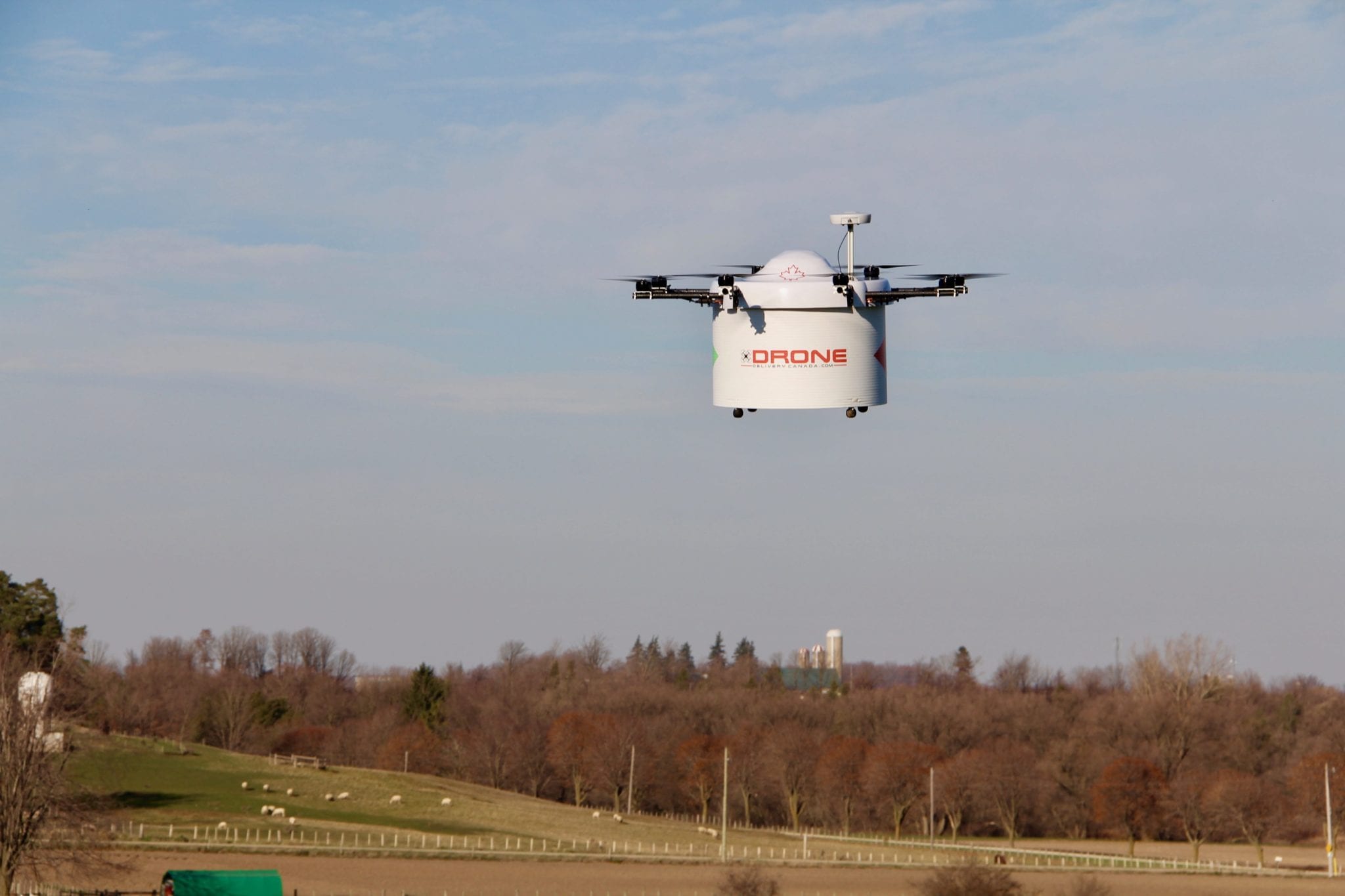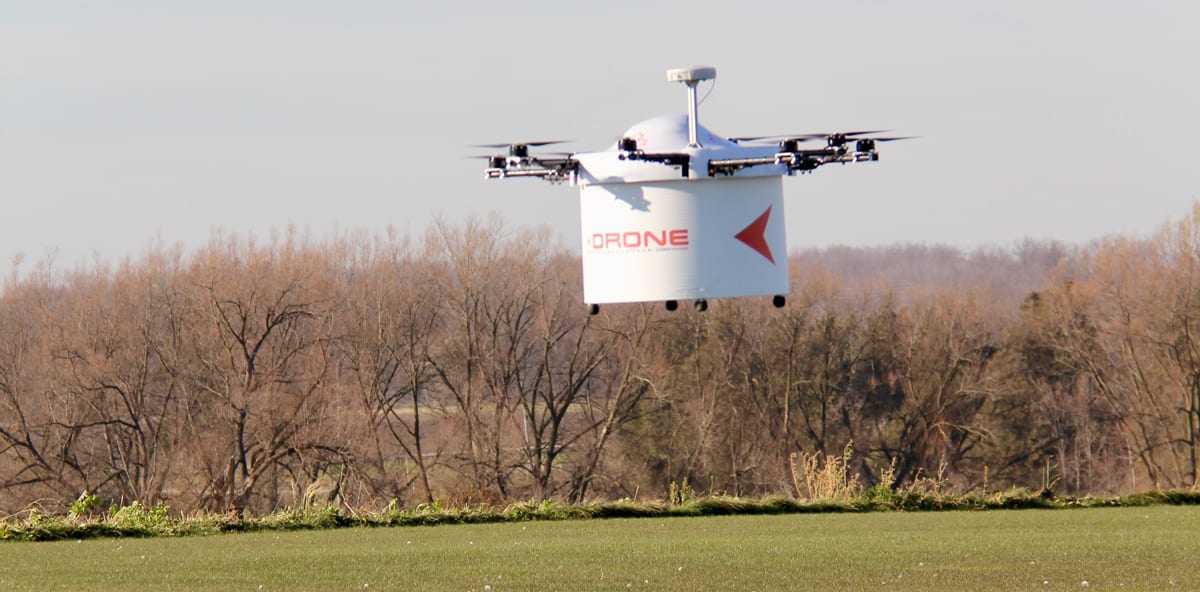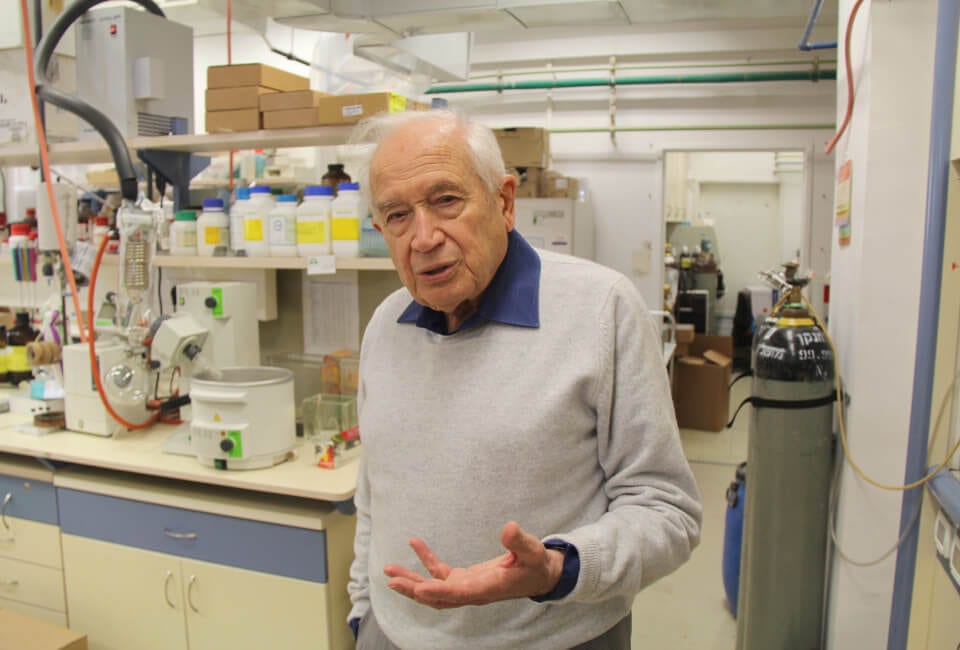Drone Delivery Canada Leading the World in Airborne Drone Technology
Anyone following my Tech Trends series in Equedia will know I’m fascinated by the potential of Artificial Intelligence and Robotics.
These two intricately linked areas of development are among the hottest trends in tech today … and have perhaps the greatest potential to completely change the world we live in.
It is also one of the fastest growing investment sectors. Leaders in this industry are growing in value at an exponential rate.
Big players like Apple, Microsoft, Amazon, Google and super villain in training Elon Musk are all investing heavily in both AI and Robotics.
But you can’t get much upside investing with an already huge company.
Today, we’ll introduce you to a publicly-listed tech company on the CSE very few people know about that is leading the way in the development of intelligent flying drones.
With its patents and its agreements with governments and major corporations, it could become a market leader in the estimated $60 billion drone transportation industry (source: MacQuarie Industry Report).
And in many ways, it is already ahead of industry giant Amazon.
But before talking about this company and its startling new technology, let’s look at the industry and where it’s going.
UNMANNED AERIAL VEHICLES ALREADY A $10 BILLION MARKET
Five years ago the sight of a remotely controlled drone was a rare thing. Today, drones are everywhere.
From tiny UAVs flying around your house and scaring your housecat, to sinister Predator drones firing Hellfire missiles at terrorist hideouts, drones are everywhere.
Drones are used for search and rescue missions, monitoring oil pipelines, filming for movies and TV, mapping out the best way to use farm land, for combat, border security and, unfortunately, occasionally by terrorists in the Middle East.
By 2014 the UAV market had soared to more than $6 billion, and that figure is conservatively estimated to hit $10 billion by 2020.
But, that growth has been slowed down by government regulations forbidding the use of drones in populated areas, at higher altitudes, and near airports.
As well, drones must currently be controlled by humans via remote control. Autonomous, intelligent drones are not allowed to operate commercially anywhere in the world.
This eliminates the mass adoption of flying robotic drones for a multitude of tasks, from surveillance to delivery.
And this is also the very problem a little known Canadian startup has solved.
BREAKING THROUGH THE LAST BARRIER TO MASS ADOPTION
The best known attempt to launch an autonomous drone program was done by Amazon, the home delivery giant run by industry titan Jeff Bezos.
Bezos is convinced drone delivery will take over the industry, and he is almost certainly right.
In 2013 Bezos was doing an interview with 60 Minutes reporter Charlie Rose, and kept hinting that he was going to give Charlie a surprise unveiling of a new technology.
A technology that would not only revolutionize the industry, but transform the world.
What he showed the 60 Minutes crew were the ‘Prime Air’ autonomous drones Bezos plans to use for home delivery.
At the time Bezos predicted the Prime Air drones would be dropping off packages in four to five years.
But that’s not really happening.
In fact, the Prime Air drones can’t even operate legally in the United States. Amazon has been reduced to small testing areas in one rural neighbourhood in the UK, and another in a remote region of southern BC.
Why?
The reason is simple. Governments rightly see the idea of autonomous drones operating freely to be far too dangerous for the public.
Should one be struck by a bird or have a malfunction in a crowded city, it could literally fall from the sky and kill someone.
Amazon didn’t solve that problem.
But a small group of seasoned tech entrepreneurs in Ontario just might have.
Drone Delivery Canada
(CSE: FLT)
Drone Delivery Canada (DDC) is a small startup, just four years in the making that has come up with a solution to make mass delivery by drones both safe and economically viable.
It’s something they can do now, and the Canadian, Ontario and Alberta governments have bought into the plan.
THE FUTURE IS HERE; YOU JUST NEED TO LOOK UP
This is not some pie in the sky, future technology.
In fact, DDC drones are already flying through the skies of southern Ontario as part of a government-sponsored technology trial.
The company already has contracts with major clients like Staples and Napa Auto Parts.
And the system works.
Drones pick up packages, fly completely on their own with no human intervention, and drop them off at a pre-determined location.
How did they do it?
Drone Delivery Canada followed a different approach than Amazon.
Where Amazon thought about what they wanted as a company, Drone Delivery Canada CEO Tony Di Benedetto turned the process upside down.
“When we looked at this we thought, we have a great idea, sure,” said Di Benedetto. “But we also thought, is the government going to allow us to do what we want to do?”
“So, instead of just moving forward on what we wanted, we talked to government and asked them what they wanted,” Di Benedetto explained. “We asked them what their concerns were, and what pain points they had that we could potentially solve.
“In other words, we talked, and we listened, and we built our business plan around what we knew we could actually do.”
The result was brilliant.
DDC’S ‘RAILROAD IN THE SKY’
The federal government, through Transport Canada, had concerns similar to those expressed by the Federal Aviation Authority in Canada. Neither wanted robot drones carrying large objects flying over people’s heads.
But DDC came up with a better idea. The company developed a new technology that creates a “Railroad in the Sky.”
And they have patented the concept and the tech behind it.
The DDC system works by creating ‘DronePorts’ in various areas. For example, a DronePort might be located at a Staples warehouse.
The second DronePort is located at a location near the recipient’s home or place of business.
The drone picks up the package, and flies along a pre-determined flight path (the railway) following a series of what Di Benetto calls digital ‘breadcrumbs’.
“By working with the various stakeholders we can find a pre-defined flight path that doesn’t go over people’s homes, doesn’t go near airports, and generally stays away from places where people will be. It’s all about safety, so in the rare event something goes wrong, nobody will be hurt.”
If an object comes near the drone, the drone has the capacity to avoid it automatically.
Also, back at DDC HQ, a fully trained human pilot has the ability to take over operation of the drone at any time.
The complex system that monitors the drone, creates the automated flight path, allows the robot to identify threats and avoid them, are all parts of the DDC package.
But not the only part.
DDC’s software also integrates directly into the software used by its clients, usually referred to as Enterprise Resource Planning (ERP) software.
This type of program is usually used to monitor things like production, inventory and shipping for large manufacturers, retail chains or distribution companies.
By integrating the drones directly into their client’s software, the drones know when a pickup is due. They move to the pickup point with no human intervention, grab the package, and fly to the drop off point.
Here is an explanation of the process:
REMOTE AREAS IN CANADA WILL LEAD THIS TECH TRANSFORMATION
The second revelation the DDC team had after meeting with governments was the huge need for drone delivery in remote areas of Canada.
Canada has the second largest land mass and among the lowest population densities in the world. The northern regions are spotted by tiny communities in rugged landscapes that in some cases are only accessible by air or water.
For that reason, it is difficult and very expensive to transport goods to these communities.
DDC’s drone fleet largely solves that problem, says Di Benetto:
“We found the federal government in general is in favour of becoming a leader in this space, but at the same time a major pain point for them is the lack of access and infrastructure in small communities, and particularly aboriginal communities,” said Di Benetto.
“In one community we’re working with the only access to supermarkets and stores is by a ferry that costs $75, so every time you need something there’s this huge extra expense,” he explained.
“We can erase most of that cost by transporting the goods by drone in a few minutes.”
PARTNERSHIP CREATES SUSTAINABLE ECONOMIES IN SMALL COMMUNITIES
The focus on remote areas was partly for safety during the early stages of the company’s development.
But DDC found a secondary mission in life.
Di Benetto says government officials made them realize the problems faced by rural communities in establishing a sustainable economy.
Running a business and making a living in a remote community is difficult when shipping costs massively inflate the prices for everyday goods, like food or medicine.
“The question we asked ourselves is, how can we help the government create a sustainable economy in these areas,” Di Benedetto recalls. “And we realized that as we create these railroads in the sky, we can also create jobs in the local community, and help people live more affordably.”
DDC is already meeting First Nations leaders in remote Ontario communities to negotiate a technology trial that will begin commercial deliveries. Di Benedetto hopes to announce its first commercial runs with a First Nations community within the next month.
THE DDC DIFFERENCE
The DDC approach is very different from that taken by Amazon.
The American retail giant has developed its own drones, and integrated those drones into the software used by its warehouses and fulfillment centres.
DDC has created the backbone software and the network, and can apply that network to any drone with advanced software.
It can also integrate its network into the software used by its clients – like Staples or Napa Auto Parts – to fully automate the process.
In other words, even much smaller companies can take part in DDC’s drone delivery services, whereas Amazon drones only deliver Amazon products to Amazon customers.
“We don’t see the value to us in the hardware of the drones,” explains Di Benedetto. “We see the value in the backbone and the network.
“It’s like a cellular network company. We don’t build the cellphones, but we do provide the network that allows the cellphones to work.”
EXPANDING THE MODEL
DDC sees the next five years as the period when it will establish a nationwide network across Canada, but primarily in rural areas. In future, as the technology improves and becomes safer, he believes DDC will start expanding into urban areas.
The company can also expand in other ways simply by purchasing the appropriate drone for the job.
Some clients, like a supermarket, will need small drones with short range. Others (like a flatpack furniture store) might need long-range drones with larger carrying capacity.
In those cases, DDC just applies their core software to the relevant drone, some of which can fly for 10 hours and carry two tons of cargo!
THE FIRST MOVER ADVANTAGE
Those interested in the Drone Delivery Space may want to look at Drone Delivery Canada (CSE: FLT) and its ability to deliver on its technology.
In March this year DDC announced its partnership with the University of Toronto and Defence Research and Development Canada to jointly develop a vision-based Drone Navigation System.
Also in March DDC was granted its third Test Flight Certificate from Transport Canada to expand testing of autonomous drones in southern Ontario.
And then on April 5th DDC began testing of its ‘Beyond Visual Line of Sight’ testing program in Foremost Alberta.
“We see the big golden nugget in this industry in owning the license, the right to fly,” says Di Benedetto. “We are the first and only company at the table today and we see big value in owning a piece of the sky.
“It’s no different than owning spectrum in the cell industry.”
Like the early cellphone providers, first movers in the drone industry could become multibillion dollar companies.
Drone Deliver Canada currently trading on the CSE under the symbol “FLT”, with share prices floating around C$0.40.
Here is the latest interview from Drone Delivery Canada on Bloomberg:
Here is another from CTV:
And one more from BNN:
By Gary Symons, Equedia
Disclosure:
Drone Delivery Canada is an advertiser.













